The last of the V8 Interceptors – from the Mad Max movies – was a car. The real thing may be something like the Dodge Durango SUV, especially the SRT 392 variant – which is equipped with the biggest V8 you can still get in just about anything.
Plus, every Durango variant is now equipped with something else, too.
What It Is
The Durango is a mid-sized, performance-themed SUV that’s available with either of two big V8s – and now comes standard with a third-row and room for seven. 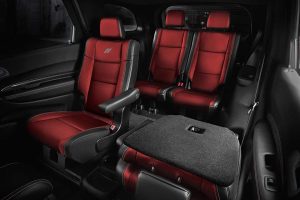
Prices start at $36,995 for the base SXT trim, which is rear-wheel-drive and comes standard with a 3.6 liter V6 – and the third row, which was formerly optional. A full-time all-wheel-drive system can be added a la carte. This raises the sticker price to $38,995.
R/T trims come standard with a 5.7 liter V8 and 360 horsepower, plus a sport-tuned suspension package and 20 inch wheels/tires. The rear-drive version lists for $49,795. A heavier-duty, truck-type 4WD system (with Low range gearing) is optional. If selected, the MSRP increases to $51,795.
For an even bigger V8 – and even more horsepower – Dodge offers the SRT 392 iteration of the Durango. It comes with a 6.4 liter, 475 horsepower V8 plus additional high-performance upgrades, including a Brembo brake package, limited slip differential and a more aggressively tuned adaptive suspension. A high-performance AWD system is standard.
This top-of-the-line Durango carries an MSRP of $68,195.
What’s New
The biggest change for the new model year is that the previously available third row is now part of the standard equipment suite in all trims. The main seating option now is to swap out the standard three-across seating in the second row for a pair of captain’s chairs, changing the people-hauling capacity from seven to six.
Tragically, the 700 horsepower Hellcat version of the Durango is gone – a victim of the Biden Thing and its determination to regulate everything that’s fun – and that we want – out of existence.
More about that follows below.
What’s Good
The V8s . . . plural.
The rows . . . standard.
The attitude . . . unique.
What’s Not So Good
The V8s are expensive – though this isn’t Dodge’s fault (more follows).
Optional DVD entertainment system all-but-eliminates center console storage space.
The Durango – as it is – probably won’t be the same for long. The current model dates back to 2010, when V8 Interceptors weren’t yet on the Endangered Species List. They are now.
The standard engine in the base SXT, next-up GT and GT-Plus versions of the Durango is Dodge’s familiar 3.6 liter V6, making 293 horsepower and 260 ft.-lbs. of torque. This engine can be found under the hood of practically every Stellantis vehicle, including those sold under the Chrysler, Jeep and Ram brands. It has proved to be a strong, reliable engine – probably in part because it has chain rather than belt-driven cams and does not have direct injection – yet.
This engine is paired with an eight speed automatic that sends the power to either the rear wheels or all four, via a full-time all-wheel-drive system. Though the Durango is an SUV – not a crossover – and so is laid out similarly to a truck (front engine, mounted front to rear; transmission bolted to the back of the engine, with a driveshaft sending power to a rear axle, primarily) there is no two-speed transfer case and so no Low range gearing. 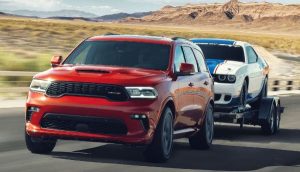
You still have more traction, however, than a rear-drive (2WD) truck or SUV and you have more toughness and capability than an AWD crossover, which because of its FWD-based layout and less-tough parts cannot pull the 6,200 pounds a Durango is rated to pull.
With the V6.
With the optional 5.7 liter V8 (360 horsepower and 390 ft.-lbs.of torque) a Durango can pull 8,700 lbs. You can also get this version of the Durango – the R/T – with either rear-drive, for burnout friendly driving – or a 4WD system that does have Low range gearing and so has more leverage – as well as traction. A heavier-duty version of the eight speed automatic is standard, either way. 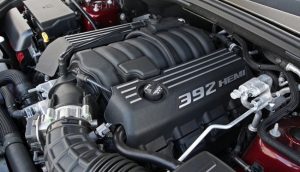
For more speed, check out the SRT 392 version of the Durango. It comes with a 6.4 liter version of the Hemi V8 that makes 475 horsepower and 470 ft.-lbs. of torque – which makes it possible for the Durango to get to 60 MPH in 4.9 seconds. This engine is paired up with a performance calibrated AWD system that is rear-drive-biased, to make the Durango feel like the muscle car with room for 6-7 it is, without sideways-slipping all over the road, as rear-drive muscle cars tend to do.
Some who’ve reviewed the Durango predictably moan about how much gas its V8s use. But the fact is, it’s not much more than the V6 uses – and it’s also beside the point, like bemoaning how many calories there are in a three-scoop hot fudge sundae. If that’s a worry, then don’t eat hot fudge sundaes. 
As for the mileage.
The V6-powered, rear-drive Durango rates 19 city, 26 highway (18/25 with the optional AWD system). With the 5.7 V8 and rear-drive, the numbers are 14 city, 22 highway. Overall, a difference of about 5 MPG. This would be a triviality were it not for the Biden Thing and its calculated actions to double the price of a gallon of gas.
The other thing is related. It is the price of the V8s. Either one is expensive, just less – or more – than the other. The least expensive V8 – the 5.7 in the R/T Durango costs almost $50k; the 6.4 in the SRT 392 costs almost $70k. Some of this cost is the reasonable cost you’d expect to pay to get more engine. It was always so. But it was not always $13k or so – the difference in cost between the V6 powered Durango SXT and the V8-powered R/T. To say nothing of the $18k or so jump in cost from the V6 R/T to the 6.4 V8-powered SRT392.
The how-come has to do with the perverse incentive – imposed by the Biden Thing – to make V8-powered vehicles cost so much that fewer people will buy them. In order that not too many will be sold, such that the 5 or so MPG deficit between the V6 and the V8 doesn’t overly hurt Dodge’s Corporate Average Fuel Economy (CAFE) scores, the agglutination of city-highway numbers posted by all the vehicles in the lineup, divided by the number of vehicles sold. It works the same as getting one “C” on your report card among the “A’s” and “B’s.” The overall average goes down – and then the fines go up.
And that’s why the cost does – so as to as to reduce the potential fines by reducing the number of V8-powered versions sold.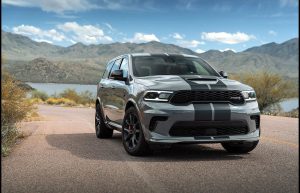
On The Road
No matter how strong a turbocharged V6 (or electric motor) may be, it will never produce the sounds – and feels – of a V8.
Even before you move.
Push the start button and hear the Durango’s Hemi exhale. Feel the rumble. It conjures emotion, in you. The same feeling Harley people know all about and wouldn’t trade in for anything that’s not a big V-twin, no matter how much power it makes or how many MPGs it delivers.
There is, however, plenty of power. And also torque – without any turbos (or electric motors) which reduces the chances of expense, down the road. One of the many virtues of a big V8 is that it is big – and thus, usually not working hard. Like a big guy who can easily pick up an 80 pound bag of cement and sling it over his shoulder. A smaller guy might be able to do it, too – but he’ll be working harder to do it. That’s what turbocharged smaller engines have to do – in order to do the work of a bigger engine.
Working harder tends to mean getting tired sooner.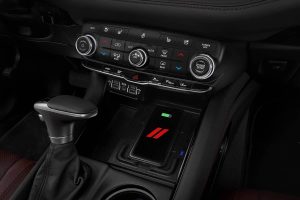
The Durango’s big V8 just aw-shucks is way through the crowd, hardly exerting itself. When just cruising along, you will hear – and feel – that comforting low-down rumble that nothing but a V8 can deliver. The accelerator pedal is your equivalent of a conductor’s baton. A bit more pitch, now. Perhaps a crescendo – as the Durango bellows by that 47-in-a-55 Prius driver. Then back to that contended burble, as you dial it back and level off.
The 6.4 V8 amps up this experience considerably. Now you’re at a metal concert, the frontman under that air-scooped hood ahead of you. Few things that don’t actually fly get half a dozen-plus people into the slipstream as quickly. Flooring the pedal is like engaging the re-heaters on Concorde’s take-off roll. That glorious bird is missed – and so will this one be.
But the V6 ought not to be missed, either.
Not because it’s a seven-passenger bullet but rather because it’s not likely to render you a passenger – in a dealership’s loaner (or your spare car) when the turbos fail or the electric motor no longer holds a charge. Because it hasn’t got either one.
The available AWD system is an interesting counterpoint to the usual (in truck-based SUVs) rear-drive or 4WD. AWD feels more seamless and you have both a traction and a handling advantage, since the layout is better balanced as well as better-biased (toward the rear).
Whichever engine you get, all Durangos share the same pleasant driving qualities – above all the lack (or less) of driver “assistance” systems. There are some but they are fewer because the Durango is – happily – older; the current model dates back to 2010. It is difficult to “update” these older platforms with all the latest electronica. There is a lane-keep system – better styled, addled-by-cell phone idiot driver countermeasure – that pulls the wheel if you stray out of your lane. But non-idiots can easily turn this off – and that’s about all there is.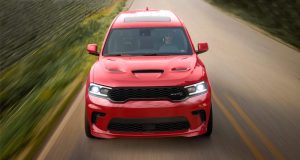
It makes driving a new Durango as pleasant as it was to drive one back in 2010 – as opposed to having your driving serially interfered with by electronica, as in newer-design stuff.
At The Curb
The Durango is a bold-looking rig, particularly the R/T and SRT iterations and especially if ordered in any of the several hard-hitting color schemes available. Some convey menace more subtly – such as the Destroyer Gray flat color that my test-rig R/T Durango was painted. That plus the scalloped and scooped hood – technically, these are air bleeds meant to vent hot underhood air and thus help keep the big V8 cool – and the massive Brembo brake calipers clearly visible through the 20 inch wheels – leave no one guessing about this thing’s intentions.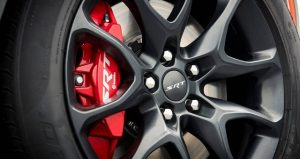
The newly standard third row is a nice perk – especially the not-having to pay extra for it. It also gives the Durango something of a functional edge over other mid-sized SUVs that don’t offer it – and three-row crossovers that aren’t SUVs.
In addition to the extra seats, you get a great deal of standard room – 17.2 cubic feet behind the third row, which is more than you’d get in any current full-sized car – and 85.1 cubic feet with the second and third rows folded, which is almost enough to house a car. It is enough to handle an impressive load of stuff, a thing at least as important as having all those seats.
Because it is an SUV, the Durango’s floor is higher than a crossover’s – and there’s a central hump running front to back, for the driveshaft. This makes the third row seaters sit up a bit higher – and their knees, too. But it’s a viable third row for teenagers and even for adults, depending on their size and flexibility.
Up front, though, is the place to be. And not just because you’re closer to the action. The driver and passenger have access to the excellent UConnect system used in this and other Stellantis vehicles. It combines the form of modernity – a large LCD touchscreen – without the need to touch (or rather, tap/swipe) it. Instead, you can use the knobs to adjust the volume – and change the station – of the standard six-speaker audio rig all the way up to the optional (and superlative) 19 speaker JBL premium audio system.
The Durango is available with a twin-screen/DVD-based rearseat entertainment system. Be advised that if you select this option, your Durango will come standard with ver little front seat/center console storage space – almost all of which is taken up by the DVD player housed within. However, there is a big center storage console cubby in between the second row chairs – if you choose the available captain’s chairs. And even if not, there is no shortage of space in other places to put things you don’t want to carry around in your pockets.
The Bottom Line
Vehicles like the Durango are a vanishing breed. If you’d rather drive one than regret not ever having done so, this might be the year to do it.
Before you no longer can.
. . .
Got a question about cars, bikes or anything else? Click on the “ask Eric” link and send ’em in! Or email me directly at [email protected] if the @!** “ask Eric” button doesn’t work!
If you like what you’ve found here please consider supporting EPautos.
We depend on you to keep the wheels turning!
Our donate button is here.
If you prefer not to use PayPal, our mailing address is:
EPautos
721 Hummingbird Lane SE
Copper Hill, VA 24079
PS: Get an EPautos magnet or sticker or coaster in return for a $20 or more one-time donation or a $10 or more monthly recurring donation. (Please be sure to tell us you want a magnet or sticker or coaster – and also, provide an address, so we know where to mail the thing!)
My eBook about car buying (new and used) is also available for your favorite price – free! Click here. If that fails, email me at [email protected] and I will send you a copy directly!




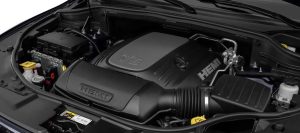
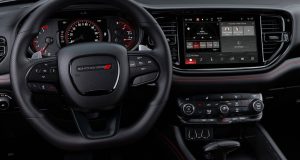









‘Step up another rung, V10 power.’ — Sparkey
Just rode in one of these a few weeks ago. Thought it was just a plain older Ram pickup till the owner punched it heading uphill, and it pinned me to the seat.
V8? I asked him. Nope, V10 plus manual trans. Made only one year, he said.
Adding: “It’s not for sale, ever.“
This write up is why I will never give up my Hemi. The sound, smoothness, and confident power when called.
Though I might be persuaded to move to a diesel one day – if they still exist.
A Dodge Durango Citadel is one cool ride, kind of an enclosed Ram pick’em up truck. 2014’s can be bought for 15,000 dollars. A good buy in today’s market.
There is a Durango Hellcat at Barrett-Jackson for 180,000 dollars.
Can be bought for 10 troy ounces of gold or 6 bitcoin, Barrett-Jackson will call the shots making the deal. In any event, the price will be 180,000 dollars that Barrett-Jackson will have to have. Might want a few more bitcoin to absorb some of the volatility in the price of bitcoin. Reduce the risky risk.
Question, would Warren trade one share of BRKa at 444,500 dollars per share earning 50,000 USD per share for 15 lousy bitcoin?
15 x 29,433 for one bitcoin is going to be 444,500 dollars, an investment worth 50 grand more from the get go.
If you have 15 bitcoins, trade them for 444,500 dollars and invest in Berkshire-Hathaway before bitcoin begins to bleed out some more. You’ll have something and will be happy.
A new Dodge Durango is 1.5 bitcoin, a bargain if there ever was one.
You gotta have some idea of due diligence, can’t make too many mistakes.
1.5 bitcoin for one brand new Dodge Durango is a no-brainer. Bitcoin is hardly a collectible like a Dodge Durango.
Make that 100 troy ounces of gold, correction done.
I can see bidding 100K in biden bucks on this in 2037 for this on bring a trailer. If gas and ICE is still legal
Hi Mark,
Such an outcome is not improbable. Vehicles like this are – truly – the last of the V8 Interceptors. I remember reading a review in Car & Driver of the 1979 Trans Am with the 6.6 400/four speed combo. The article concluded with, “it shall not pass this way again.” 1979 was the final year for the big Pontiac V8. I remember being saddened – and angered – by this, because I was too young to drive and realized I would never get to drive a new car like that. But at least there were still other cars – and SUVs – for me to drive. Now those are being taken away from us, too.
God damn them.
It was the same way for me in 79, and a older neighbor had just gotten a new 79 Z28. We ogled over the car.
Hi Chris,
I once owned an ’80 Z28, basically the same as the ’79 except for the functional “air induction” scoop the ’80 (and ’81) cars had vs. the dummy on the ’79 (and ’78) models; the ’77 only had a sticker meant to echo a scoop’s outlines!
Not very quick as delivered – all of 180-190 horsepower. But the 350 was a small block Chevy and very amenable to bolt-ons and tweaking. A set of headers – and nix the awful y-pipe/single cat/dual resonator exhaust – made a huge improvement, especially if accompanied by a power tune to match. I never dyno’d one, but I would bet this mod alone freed up another 20 or so horsepower. Now add a performance cam and you really had something… !
Check this out: https://www.youtube.com/watch?v=SHDP_RQ4qY8
he did all of that and made his scoop functional. We were in awe……
I’ll miss V8s, our last holdout is our 91 Silverado with a 350 engine. Can’t beat cast iron for long life.
Step up another rung, V10 power, wonder what this will be worth down the road:
https://jalopnik.com/you-should-all-be-aware-that-in-2003-dodge-offered-an-8-1843832116
A whole lot cheaper way to get a Grand Wagoneer! However your Durango may get waved off into staff parking at “The Club” instead of Grand Wagoneer pole position out front.
Practical Durango vs snob appeal of the Grand Wagoneer. Same guts different costumes.